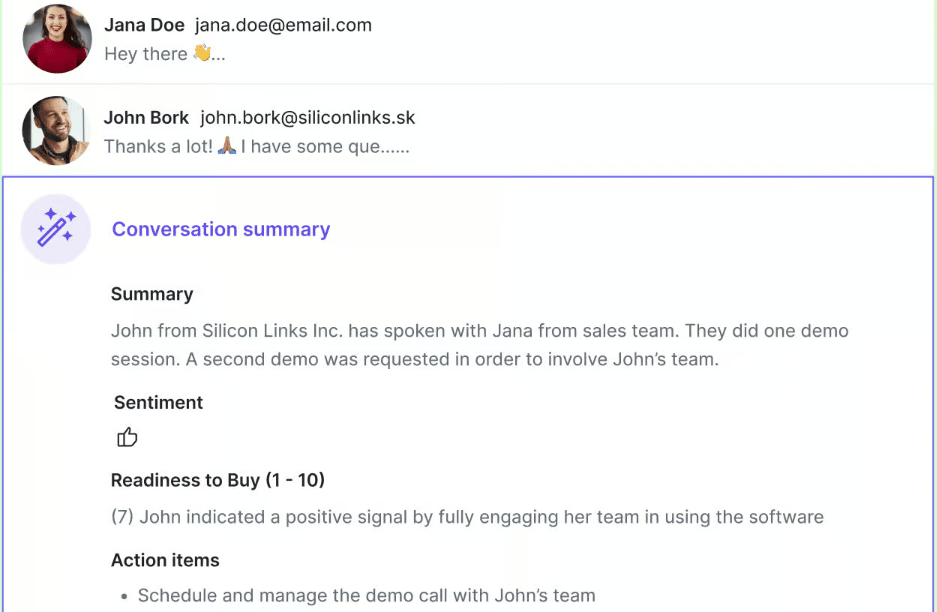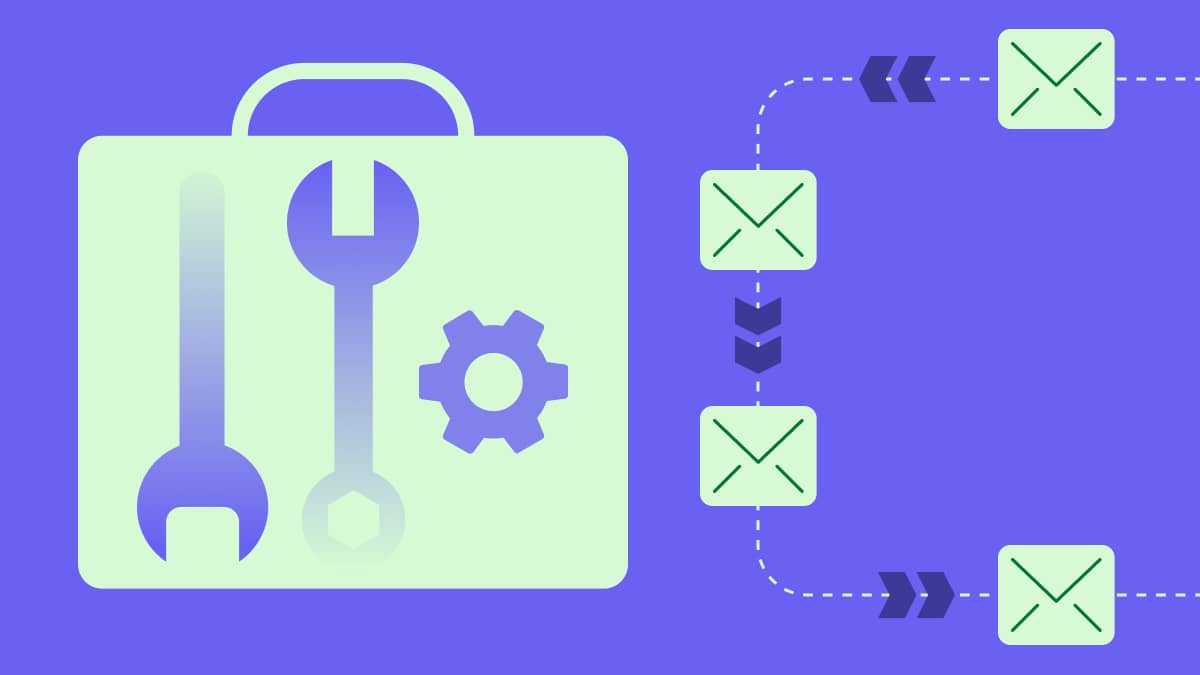Many marketers use email generators to keep up with demand for instant outreach messages and replies.
The latest AI tech and other tools can help you speed up email creation and improve the customer experience. However, as with any tool, you must understand how it works and how to use email generators properly for the best results.
In this article, we’ll explore the latest email generator technology and how you can employ it to scale your email marketing efforts effectively.
What is an AI email generator?
An AI email generator utilizes artificial intelligence to compose, personalize and optimize messages in less time.
The user provides a prompt with specific information like tone and length, and then the AI software creates drafts. Marketers can segment emails to particular demographics using the AI-generated email as a blueprint (more on that later).
Note: Third-party AI systems aren’t entirely secure. The tools use data to “learn”, and you don’t want company or customer information to leak. Avoid inputting sensitive data into your prompts as you develop emails.
Marketing automation software and email templates also help users improve their outreach. Email marketers and salespeople can combine established email marketing tools with AI technology to increase engagement and conversion rates.
How email generators can help marketers and salespeople
AI email generators speed up the process of creating content, allowing marketers and salespeople to scale their workflows.
These tools can assist with every email marketing stage, from planning your campaign to optimizing existing emails.
Here are three ways an AI email generator can help.
1. Using AI to generate email campaigns
AI email generators can create entire emails with only a few prompts.
Marketers and salespeople input basic details like the type of email they want to send, key points to include and tone of voice. AI generators then use machine learning algorithms to generate relevant content, such as subject lines, body text and calls to action (CTAs).
Here’s an example of a promotional email from AI writing assistant Rytr:

Some AI tools go further. For example, ChatGPT can help you plan and draft entire email campaigns. Once you input relevant prompts, the tool suggests the content of each message.

These resources enable email marketers and salespeople to free up resources and focus on other, more strategic aspects of the business.
2. Using AI for email content personalization
When used correctly, AI can help you create messages that personalize every element, from the greeting to the email signature.
For example, segmentation has always been vital in email marketing. Dividing your audience based on specific characteristics such as demographics, interests and behavior lets you send them more relevant content. AI can help you create highly targeted and dynamic segments.
One of AI’s biggest strengths is its ability to process and analyze large amounts of data. Using it to assess customer behavior and interests allows marketers to segment their audience more precisely and effectively.
AI can also help you personalize by using predictive text. For example, Google’s Smart Compose offers suggestions tailored to your writing style as you type new emails.
Similarly, Gmail accounts offer Smart Reply, which uses machine learning to improve your email responses.
The latest email generators allow you to predict what will resonate with a specific audience and generate personalized content accordingly. AI can also create dynamic messages, changing the copy in existing emails based on individual customer behavior and interests.
A dynamic email might show different product recommendations based on a customer’s previous purchases or browsing behavior.
For example, Amazon keeps prospects engaged by recommending products specific to their browsing histories. The company analyzes past views and purchases and proposes similar items or titles for review.

Creating highly personalized emails helps marketers stand out in a crowded inbox and leads to higher conversion rates.
3. Using AI for email content optimization
AI email generators can also help marketers optimize existing emails, improving their effectiveness and driving better results.
Spelling and grammar assistants are among the most familiar uses of AI. Although these checks may seem basic, they help you create professional and effective emails.
A standard, old-school spell check isn’t going to find a correctly spelled word that’s misused.
AI tools analyze the context of your email to automatically correct spelling and grammar issues, ensuring your emails are error-free and polished.
For example, here’s AI writing assistant Grammarly in action:

AI can also help optimize after you hit send by analyzing data on open rates, click-through rates and other email engagement metrics. The results identify patterns you can use to improve email content and performance.
Insights may include the best time to send emails, which cold email subject lines are most effective and which types of content resonate with the target audience.
Real-time optimization can also improve current campaigns. For example, if open rates are lower than usual, AI might adjust the subject line or send time to enhance engagement.
AI helps email marketers achieve better results and drive business success by making it easier to identify and correct errors, improve content quality and optimize performance.
Heat up your cold emails with 25 customizable email templates
What about email address generators?
There are other types of email generators you should know about that create temporary or one-time email addresses.
Many people hesitate to give out their real email addresses, worrying they’ll get spam or unwanted notifications. As a result, if they’re signing up for a new service or trying to download a gated resource through a pop-up, they may use an address generator to create a random email address.
Some popular temporary email address generator tools include:
TrashMail
10MinuteMail
YOPmail
Temp Mail
FakeMail
While features vary, each tool provides users with a temporary email address that’s automatically deleted after a specific period.
Marketers and salespeople may not use these tools themselves, but knowing whether your prospects use a fake email address generator is helpful. Messages sent to temporary or deleted email accounts may bounce, hurting conversion rates, damaging domain authority and potentially leading to emails being flagged as spam.
Keep your email deliverability high by periodically validating any emails on your list and blocklisting known temporary address domain names and email services. Dedicated tools like MailerCheck and ZeroBounce regularly check your list and flag “burner” emails before they do any damage.
How to use AI email generators effectively
AI isn’t a replacement for human creativity. Email content generators can’t write engaging copy without human input.
For example, in its blog post introducing the tool, OpenAI discussed ChatGPT’s limitations, including factually incorrect or wordy content.
To prevent potential issues from undermining your campaigns, always fact-check your emails and edit them to match your company’s tone of voice.
Remember that the results you get will largely depend on your input. Asking an AI tool to “write a sales email” without more information will generate a generic message.
Include details in your prompt, such as:
The email recipient
The purpose of your email
Relevant information about your product or service
The tone of voice
Any style and formatting preferences
These specifications will help prevent robotic-sounding emails and ensure your message stands out in the customer’s inbox.
AI tools still require effort and skill to achieve the best results, but email generators can help marketers and salespeople write first drafts and give them more time to fine-tune the content
7 top tools for email generation
Many tools are available to help marketers create high-quality emails that resonate with their target audience. Here are seven of the top options available now.
1. Pipedrive AI Email Writer
Ideal for integrating email generation with your CRM

Effective personalization involves more than using the recipient’s name. It means sending a relevant email that references the customer’s current situation.
Pipedrive’s AI email writer turns user prompts into high-quality sales emails, building valuable connections in less time.
Write a prompt for the type of content you want to produce, then choose the email’s tone, style and length. Finally, edit the results and hit send. This efficient process helps you engage prospects and keep the sales cycle moving.
In addition, Pipedrive offers an AI email summarizer that recaps conversations and keeps teams updated so you can send the perfect response to convert prospects faster.
Both tools allow you to leverage data from your existing customer relationship management (CRM) system for an efficient all-in-one solution that integrates with popular email clients like Gmail.com and Mailchimp.
2. ChatGPT
For versatile content generation

ChatGPT can generate emails and outline campaigns through its Chrome extension. Here’s how ChatGPT responds when asked how to use its technology for generating emails:
Note that ChatGPT has downsides. The free tier of GPT-4o has usage rate limits that cap how many prompts you can try in a set time frame.
3. Grammarly
For sending out emails that match your brand

Grammarly analyzes content using AI techniques like machine learning, deep learning and natural language processing.
One notable feature is the tone detector, which analyzes an email’s language and style. The app determines how the email will come across by examining word choice, phrasing, punctuation and capitalization.
For example, it may detect that the email sounds too formal, casual or potentially offensive. Use this information to make adjustments that ensure each email matches the company’s tone of voice.
4. Rytr
For generating emails and other content

Rytr is a straightforward email generator that allows users to create all kinds of AI-based content.
After confirming the use case, language, tone of voice and creativity level, type in the email’s purpose and any keywords to include.
5. Reply
For generating sales emails

Reply is a sales engagement platform that enables teams to automate cold outreach across multiple channels.
Its AI Email Assistant includes many templates to get users started, along with access to the GPT-3 model to expand on ideas. As you edit the email, use the email quality check to calculate the likelihood of a response.
Reply’s AI agent Jason also promises personalization, with features like multi-channel automation, real-time B2B data and a deliverability toolkit.
6. Writer
For enterprises that need a specialized AI writing tool for the entire organization

Writer is an AI tool that helps enterprise teams create company-specific writing. It “reads” through company content, facts and style guide to customize an AI model for the business.
Its features include an internal style guide and a library of approved snippets.
Writer integrates with standard writing tools like Google Docs, Outlook, Chrome and Word. Because the software is for enterprise use, it also complies with PCI-DSS, SOC 2 Type 2 and HIPAA.
7. Hyperise
For generating personalized images and videos

Prospects and customers often see basic personalization in email text, meaning salespeople and marketers must go further to make an impact. One way to achieve this goal is to add original images and videos to emails.
Hyperise promises users “hyper-personalization”, meaning users can add dynamic text to an image or video. For example, send a photo of the company president holding a coffee cup with the potential customer’s name on it or link to a video with the business company logo on a whiteboard. Add interactive buttons and text-to-speech for increased personalization.
Final thoughts
Writing sales and marketing emails is often complicated and time-consuming, but the right email generator software can speed up the process. However, these tools aren’t a replacement for creative thinking and strategic planning. They still need human input and oversight.
Explore the features and functionality of any email generator tools you use and set up proper guidelines for data security. Test the tools on a small scale before incorporating them into your larger email marketing campaigns to engage your audience and optimize results.







